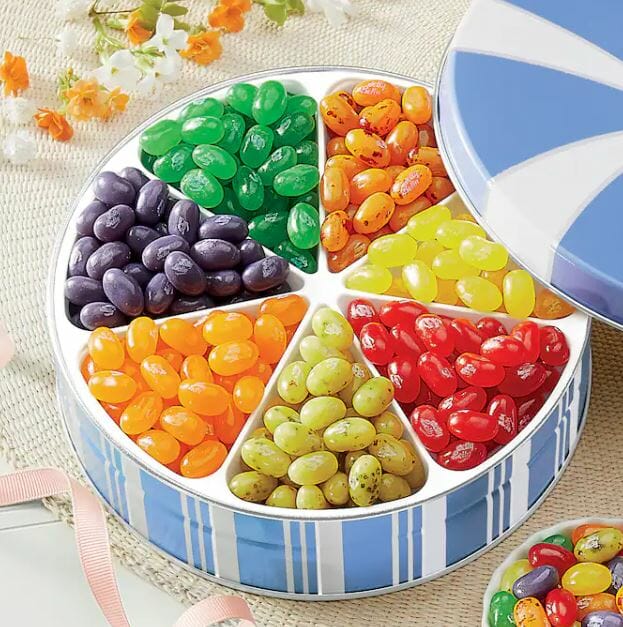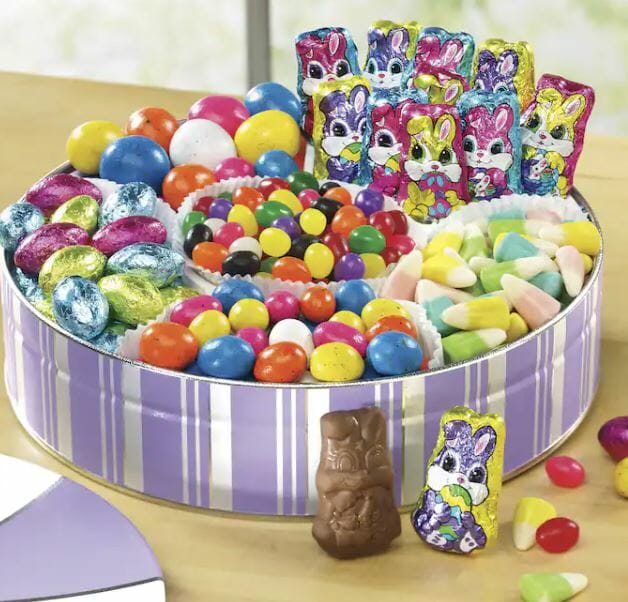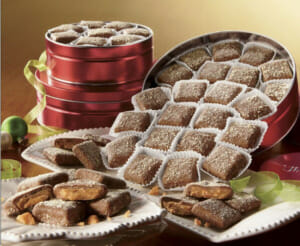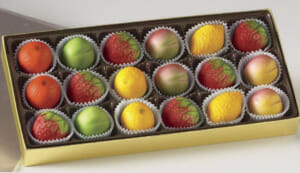History of Jelly Beans: What Are They, and What Are They Made of?
What are jelly beans made of? When were jelly beans invented? Learn the history of jelly beans, including Jelly Belly® — by far the world’s most popular brand.
What comes in a nearly endless supply of flavors and colors, contains about 4 calories, has two days named after it, and has been an important part of Easter baskets, holiday gifts, and other events for decades?
It’s the jelly bean!

What are Jelly Beans made of?
Despite its name, this bean-shaped candy is not a bean, and it doesn’t have the flavor of jelly. Jelly beans are made primarily of sugar and corn syrup, thickened with cornstarch. That simple base makes the perfect canvas for a varied palette of flavors and bright colors that makes jelly beans the perfect choice for kids’ gift baskets—and plenty of grownups love them, too! Jelly beans also contain ingredients like confectioner’s glaze, beeswax, and carnauba wax to give them their unique consistency and texture.
And yes, there are two “holidays” recognized in the United States: April 22 is National Jelly Bean Day, while July 31 is Jump for Jelly Beans Day. Admittedly, not too many people observe these “holidays,” but it never hurts to have something fun to celebrate…and these treats have been part of our celebrations for many years.

When were Jelly Beans invented?
No one really knows when jelly beans were invented, but the idea has its origin in Turkish Delight. Also known as lokum (loh-KOOM), this Middle Eastern jelly candy covered in powdered sugar or cornstarch has been around since biblical times. While its chewy texture was an inspiration for jelly beans’ filling, their shells actually derived from Jordan almonds, which are sugar coated by shaking in a container of syrup: a process invented in France in the 1600s.
History of Jelly Beans
Over time, jelly beans would become more popular than their predecessors…but not until 1861, when Boston confectioner William Schrafft urged people to send his jelly beans to soldiers in the Union Army during the American Civil War. In 1905, jelly beans were advertised in the Chicago Daily News at 9 cents a pound.
Jelly beans eventually become associated with the Easter holiday in the 1930s, probably due to their egg-shaped appearance. Today this Easter candy is popular year-round, thanks to famous devotees like the Beatles and President Ronald Reagan…not to mention the bizarre flavors inspired by the Harry Potter movies of the 2000s. Those were concocted by Reagan’s preferred brand, a Midwestern company called Jelly Belly®.

Jelly Belly® Jelly Beans
Founded by 24-year-old Gustav Goelitz in Belleville, Illinois, the Goelitz Confectionery Company made a variety of candies, including candy corn and “royal buttercreams.” Goelitz’s descendants introduced jelly beans (along with other penny candy like tangerine slices and spice drops) in the 1960s, and made a substantial breakthrough in 1965 with the infusion of flavors in the centers of their Goelitz Mini Jelly Beans. These were discovered by Reagan the following year, and by 1973, according to a letter he wrote the company, “We can hardly start a meeting or make a decision without passing the jar of jelly beans.”
In 1976, David Klein started a distribution company called Garvey Nut in Temple City, California. He came up with an idea for a new kind of jelly bean he named “Jelly Belly” and asked the Goelitz Company to make them for him.
Jelly Belly® Jelly Beans were introduced that year in a modest eight colors and flavors: Root Beer, Green Apple, Licorice, Cream Soda, Lemon, Tangerine, Very Cherry, and Grape. Klein and his partner sold Jelly Belly to the Goelitz Company for nearly $5 million in 1980. The array of colors and flavors expanded to 40 in the 1980s, as America discovered its now-President Reagan was a fan. The Herman Goelitz Candy Company relocated to Fairfield, California, in 1986 and began offering public tours shortly thereafter.
Inspired by the Harry Potter series of books and movies, Goelitz introduced Bertie Bott’s Every Flavour Beans®, in freaky flavors like Dirt, Bacon, and Spinach. This was around the time the company opened a second public tour at its plant in Pleasant Prairie, just outside Kenosha, Wisconsin, and the company itself was renamed Jelly Belly Candy Company.
While the Jelly Belly Express in Pleasant Prairie takes fans on an exploratory indoor train ride, the company’s BeanBoozled game offers a totally different experience with ten lookalike pairs of wildly contrasting flavors. You never know whether you’re getting the popular Buttered Popcorn or Rotten Egg, Juicy Pear, or Booger…until you dare to take that bite.
Today Jelly Belly jelly beans are made in more than 100 different flavors. They’re gluten-free, dairy-free, fat-free, vegetarian-friendly, and certified Kosher…and for those with the very common food allergy, they’re made in a peanut-free factory thanks to the retirement of the Peanut Butter flavor. According to the company, one ounce (25 pieces) contains about 100 calories, which you can dance off in about 15 minutes…so go ahead and “jump for jelly beans”!



Comments (9)
หวยฮานอย
Great article, exactly what I was looking for.
Jean Luevane
I love your web site! If you are asking for numeric data, it automatically goes to the number keyboard; no constant switching back and forth. Ordering online is easy and convenient. Thanks.
.
Thank you for teaching me about the history of jelly beans.
David Klein
This is David Klein….inventor of Jelly Belly Jelly Beans..Thank you for a great article.
D.LeGrand
My Family’s enjoy all of the Holiday Gift Baskets from your company. I want to wish your company a very Merry Christmas .
Ch
Hey you got to remember that you can take two different flavors and put them together and have a completely different flavor fun fact
Patrick Lamaster
Send me book to me
Boris
Good morning this is shiraz bakery we need a parve gelatine for my bakery
Talk Hay Fever
I often look around the internet these days searching solutions to my hay fever. I like to research about new ideas, techniques that I may not have tried before. I really loved reading the posts on your site. Thank you for sharing.